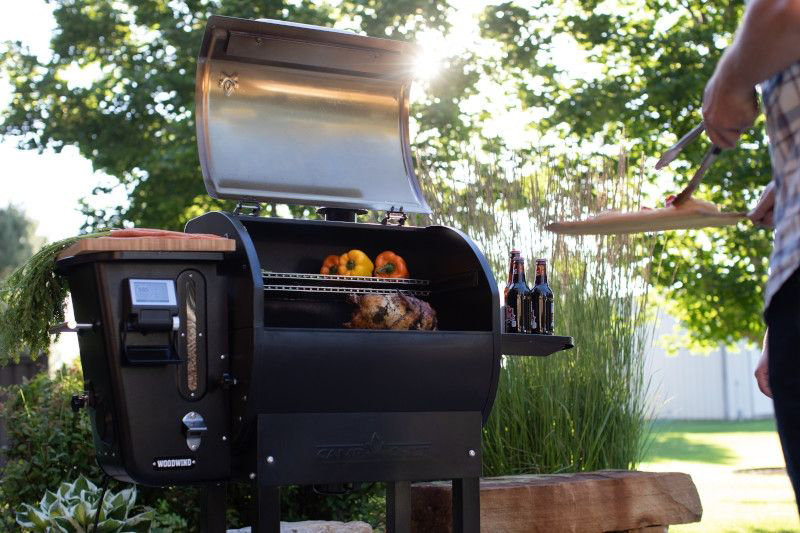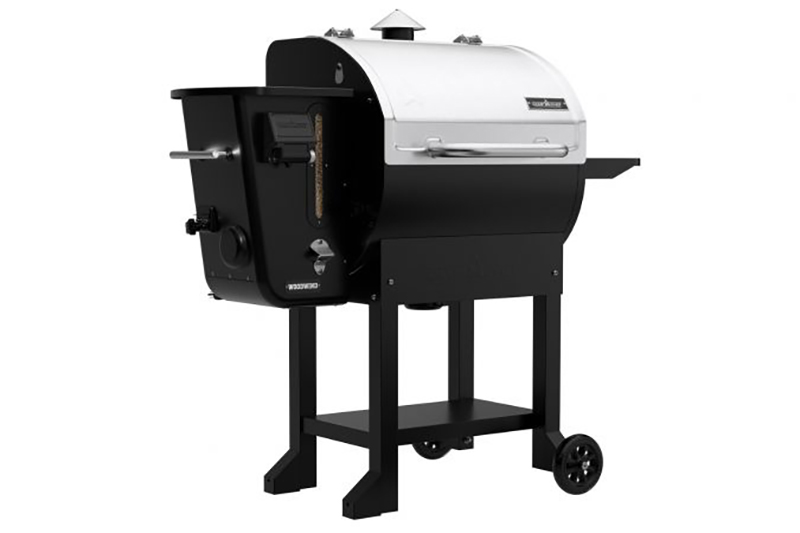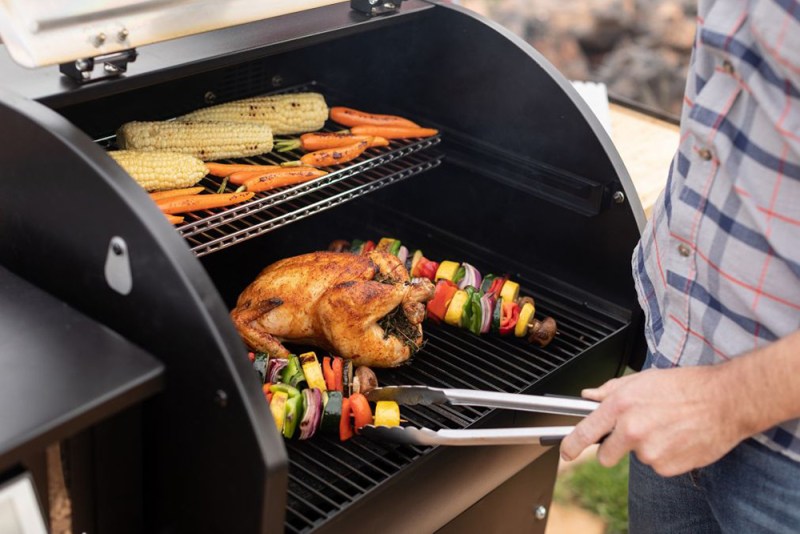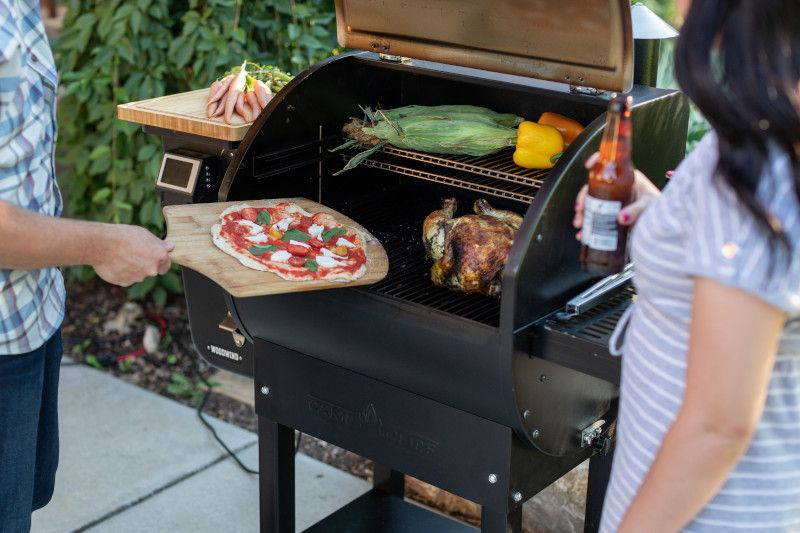
As we men get older, we begin to gain a taste for the finer things in life. We trade in the cheap beer for the nice craft brews. We finally part ways with our old band t-shirts and start buying some sophisticated threads. And perhaps the way we can tell we are becoming all grown-up is that our charcoal grill just isn’t cutting it anymore.
If you’re experiencing these changes and are unsure of exactly what to buy to up your grilling/smoking game, a pellet grill is an excellent way to do it — and the Camp Chef Woodwind Wifi 24
Related Guides
Let’s talk briefly about the differences between pellet grill smoking/grilling and the more traditional charcoal methods before we get into the review.
If you’re unfamiliar with how a pellet grill works, it grinds, heats, and smolders wood pellets made from condensed wood shavings. The grill does this by sending the pellets through an auger to grind them, and then a hot coil will set them aflame. This means that you’ll need an electrical outlet to plug into, which is something to consider if you plan on setting up your grill somewhere that doesn’t have electrical access.
Since a pellet grill runs on electricity, it has a temperature control system (just like your oven). It can maintain a consistent temperature for very long periods by feeding more pellets into the flame when it senses a temperature drop. This makes pellet grills an excellent set-and-forget grill for extended slow-and-low smoking sessions. With many pellet grills now featuring Wi-Fi that connects to an app, it’s even easier to perform a day-long smoke without opening the grill once.
One thing that a pellet grill/smoker can’t offer is that traditional, smoky charcoal flavor — since no charcoal is used in the heating process. However, if that’s what you’re looking for, keep in mind it’s much harder to control the temperature of a charcoal smoker. You have to babysit your smoker, which is why pellet grills/smokers are so appealing to so many people right now.
So now that we’ve covered how a pellet grill/smoker works and the main differences between them and charcoal, let’s get into the Camp Chef Woodwind Wifi 24 review.
Out of the Box

I have to admit, since I’ve never received a grill by mail before, I was a little worried about how it was going to come. Was I going to have to piece together an entire grill, or was it going to be mostly assembled in an enormous box that I wouldn’t be able to move on my own? It turned out to be more of the latter. Although I did manage to get it in my door by myself, I would suggest having someone help you move it if you’re trying to carry it more than a few feet.
When opening the box, though, almost all of the hard work has been done for you. The grill and pellet hopper come pre-assembled. You can plan on attaching the legs, side-kick (shipped separately), and other smaller parts. The directions were pretty straightforward, and all in all, it was fairly easy to assemble. Still, plan on blocking out at least two hours to put this bad boy together.
Design
Once assembled, this Camp Chef grill is a thing of beauty. The stainless steel door and trimming look great against the rest of the black cast-iron body. Once constructed, this grill is very heavy. However, the handle attached to the hopper makes it reasonably easy to move the grill around, thanks to the wheels. The heavy, stainless-steel lid not only looks great but does a great job of holding in smoke.
On the inside of the grill (from the bottom up), there’s a thoughtfully designed stainless steel drip pan that slopes down, protecting the heating element, and guiding grease toward the hanging grease bucket. Above that, you have an enamel-coated, cast-iron grill grate designed for your heavy-duty jobs. Above the cast-iron grates are stainless steel grates, designed to house more delicate foods farther from the heat source. All the grates remove easily for cleaning and maneuvering around the grill.
How it Cooks

This was my first time operating a pellet grill. All of my previous smoking was done with a classic vertical charcoal smoker, so it took some reading through the manual to make sure I was doing things right. Fortunately, the manual has detailed step-by-step instructions on how to fire up your grill for the first time, as well as tips on maintaining the grill over time.
The first thing Camp Chef recommends is to heat up your grill to 350 degrees F for 30 minutes to burn off manufacturing oils and cure the paint. After this step, you’re ready to enter a whole new realm of barbecuing awesomeness.
I decided to go pretty big with my initial smoke. I prepped a pork loin, a whole chicken, and a turkey leg for around a four-hour smoke, at between 225 and 250 degrees F. Before doing so, I utilized the sidekick for searing my pork loin (after seasoning the cast-iron griddle, of course). This portion of the grill runs directly off propane and can get roaring hot. The cast-iron griddle is super heavy-duty and provides a lot of space. I’m looking forward to trying out the sidekick again to reverse sear a nice, thick ribeye.
The turn dial control panel is easy to use. You simply select your temperature and then press in the dial to set it. The grill adjusts to your desired heat level, then you choose your smoke level, one being the lowest and ten being the highest. I went straight for level 10 to see how close this unit could get to replicating the smoke from my charcoal smoker.
The grill’s PID (Proportional. Integral. Derivative) temperature control system adjusts the grill’s smoke levels by smoldering more pellets. This system runs on a loop and can cause minor fluctuations in the cooking temperature when smoke levels are increased. However, when I cooked at a level ten smoke, the most the temperature would fluctuate was eight to ten degrees for around five minutes. In the long run of a slow-and-low smoke, these small temperature fluctuations are nothing. Just keep in mind, the more smoke you crave, the harder the grill will need to work to produce the smoke. So, if you want to maintain an exact temperature for the entirety of your smoke, selecting a lower smoke level is best.

A fantastic feature of this grill is that it comes with four temperature probes you place in your meat to monitor its temp for the duration of the cook (as long as you keep it below 350 degrees). If you’re cooking on high heat, you can still use the probes for instant reads, but leaving them covered in a high heat grill will damage them.
Although the on-grill controls are simple to use, the app is what ties all these features together. Through the app, you can set both your heat and smoke levels and set target cook temps for your meats. Once your meat reaches its target temp, the app will notify you (you can also monitor the probe temps on the grill’s control panel). Once you create an account through the app, you can track all your previous cooks and prove to your friends how perfect that brisket you cooked was a couple of months back.
Overall, everything came out perfect thanks to the PID temperature control system and the probs. This grill makes smoking meats virtually foolproof. Never having used a pellet grill before, I was worried that it wouldn’t give me the deep-smoke flavor I’ve become accustomed to with charcoal. The meat’s smoky flavor was delicious, well balanced, and not overpowering — like charcoal can sometimes be. It has a cleaner taste, which allows for your seasonings and the meat’s natural flavor to shine through. The bottom line is, for me, there’s no going back to charcoal.
Value
There’s no arguing; $1,000 is a hefty investment for a grill, given you can buy a good charcoal grill/smoker for under $200. But, if you think about what you’re getting, it’s pretty reasonable. What this grill provides is not only the ability to cook perfectly smoked meats; it gives you the ability to multitask. You can mow the lawn, play cornhole with friends, or even go for a run and let the grill do the majority of the work. With traditional smokers, you constantly have to monitor the temp and add woodchips. With the Camp Chef Woodwind WiFi 24 you can reclaim your time, which we all know has always been the most valuable commodity.



